 FORWARD INTO THE ATTACK WITH THE 4TH ALABAMA!
FORWARD INTO THE ATTACK WITH THE 4TH ALABAMA!
The rainbow signifies the 167th Infantry fighting with the 42nd "Rainbow" Division in WWI. The 5 x Fleure de-lis on the rainbow = the 5 major actions the 167th Infantry fought in WWI France 1917-18. The 13 x Battle Stars = the 13 major battles the 4th Alabama fought in the Civil War, 1861-1865. The Red Cross is the "Rouge de Croix"; a key French farmhouse taken by the 167th Infantry in WWI.

View Our Guestbook Sign Our Guestbook
Sign Our Guestbook
View Old Guestbook (new guestbook started 25 Feb 01)
If you would like a recruiter to contact you, click here
Join the 4th Alabama Chapter of the National Infantry Association!
NIA Chapters Listing
www.infantryassn.com/chapters.htm
"Don't go where the path may lead, go instead where there is no path and leave a trail".
""Stay low, keep 10 meters apart, and return well aimed fires"
"GOD LOVES A GRUNT"

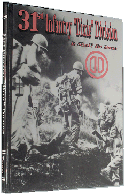 ORDER OUR UNIT'S HISTORY! See us fight through the jungles, sail and land across the Pacific, climb up the hills of Korea and drive into the future!
ORDER OUR UNIT'S HISTORY! See us fight through the jungles, sail and land across the Pacific, climb up the hills of Korea and drive into the future!
31st Infantry Division History by Turner Publishing
SHOULDER PATCH: the patch is a white disk on which is a red circle. Within the circle are two red D's, back to back. The D's stand for "Dixie Division", the 31st having drawn its strength in World War I from National Guard units of Florida, and Georgia and in WWII from Louisiana, Mississippi, Alabama, and Florida.
TYPE OF DIVISION: National Guard
NICKNAME: "Dixie Division".
SLOGAN: "It Shall Be Done".
4th ALABAMA VETERANS KNOW YOUR MODERN HISTORY:
WWI
The division was organized in Oct. 1917 at Camp-Wheeler, Ga., and went overseas during Sept., Oct., and Nov 1918. Upon arrival in France it was designated as a replacement division. The personnel of most of the units were withdrawn and sent to other organizations. 41 somewhat skeletonized division units remained at Brest returning to the U. S. in Dec. 1918, and was demobilized early in 1919. The 31st was reorganized in 1923 as a National Guard division with its several component units coming from La., Miss and Fla. The 124th Infantry Regiment was organized from companies which date back to June, 1921, A cross of red on the shield is from the flag of the State of Florida. The 155th Infantry Regiment dates back to 1798 when it was organized as the Adams County, Miss., Militia. It fought in the War of 1812, the Creek Indian War, the Mexican War and then, as the First Mississippi Volunteers, it participated in the War Between the States. When World War I broke out it was stationed on the Mexican border and later saw service overseas with the 39th Infantry Division. Its regimental motto is "Stand Fast." The 167th Infantry Regiment comes from the 4th Alabama Regiment and originated in this new designation on 15 July 1911. During World War I, the 167th fought as part of the 42d Infantry "Rainbow" Division.
167th Infantry Congressional Medal of Honor Winners:

MANNING, SIDNEY E.
photo
Rank and Organization: Corporal, U.S. Army Company G, 167th Infantry, 42d Division. Place and Date: Near Breuvannes, France, 28 July 1918. Entering service at: Flomaton, Ala. Born: 17 July 1892, Butler County, Ala. G. O. No.: 44, W.D., 1919.
Citation:
When his Platoon Commander and Platoon Sergeant had both become casualties soon after the beginning of an assault on strongly fortified heights overlooking the Ourcq River, Cpl. Manning took command of his platoon, which was near the center of the attacking line. Though himself severely wounded he led forward the 35 men remaining in the platoon and finally succeeded in gaining a foothold on the enemy's position, during which time he had received more wounds and all but 7 of his men had fallen. Directing the consolidation of the position, he held off a large body of the enemy only 50 yards away by fire from his automatic rifle. He declined to take cover until his line had been entirely consolidated with the line of the platoon on the front when he dragged himself to shelter, suffering from 9 wounds in all parts of the body.
NEIBAUR, THOMAS C.
photo
Rank and Organization: Private, U.S. Army, Company M, 167th Infantry, 42d Division. Place and Date: Near Landres-et-St. Georges, France, 16 October 1918. Entered Service At: Sugar City, Idaho. Born: 17 May 1898, Sharon, Idaho. G. O. No.: 1 18, W .D., 1918.
Citation:
On the afternoon of 16 October 1918, when the Cote-de-Chatillion had just been gained after bitter fighting and the summit of that strong bulwark in the Kriemhilde Stellung was being organized, Pvt. Neibaur was sent out on patrol with his automatic rifle squad to enfilade enemy machinegun nests. As he gained the ridge, he set up his automatic rifle and was directly thereafter wounded in both legs by fire from a hostile machinegun on his flank. The advance wave of the enemy troops, counterattacking, had about gained the ridge, and although practically cut off and surrounded, the remainder of his detachment being killed or wounded, this gallant Soldier kept his automatic rifle in operation to such effect that by his own efforts and by fire from the skirmish line of his company, at least 100 yards in his rear, the attack was checked. The enemy wave being halted and lying prone, 4 of the enemy attacked Pvt. Neibaur at close quarters. These he killed. He then moved alone among the enemy lying on the ground about him, in the midst of the fire from his own lines, and by coolness and gallantry captured 11 prisoners at the point of his pistol and, although painfully wounded, brought them back to our lines. The counterattack in full force was arrested to a large extent by the single efforts of this Soldier, whose heroic exploits took place against the skyline in full view of his entire battalion.
WWII
INDUCTION DATE: 26 November 1940
INACTIVATION DATE: 21 December 1945 at Camp Stoneman, California.
TRAINING UNDER ARMY GROUND FORCES: The 31st was assigned to Camp, Blanding, Fla., on its induction. It took part in the Third Army maneuvers held in Louisiana in Sept. 1941 and in Nov. 1941 participated in the maneuvers held in the Carolinas under GHQ and the IV Corps. Early in 1942 it moved to Camp Bowie, Texas, and on 9 March 1942 came under the Army Ground Forces. From Aug. to Sept. 1942 the Dixie Division played an important part in Third Army maneuvers in Louisiana and at the completion of maneuvers moved to Camp Shelby, Miss. During July and Aug. 1943 the division was part of the Third Army which maneuvered in Louisiana. Upon completion of maneuvers the 31st moved to Camp Pickett, Va.
OVERSEAS TRAINING: Trained briefly at Oro Bay, British New Guinea, prior to entering combat.
DEPARTED U. S. FOR FOREIGN DUTY: 12 March 1944
RETURNED TO U. S.: 21 December 1945 (HQ)
Inducted into federal service as the 31st Division at Birmingham, Ala. on 25 Nov 40 and moved to Camp Blanding, Florida.
Moved to Louisiana Maneuver Area 4 Aug 41 where participated in the Aug 41 IV Corps Louisiana Maneuvers and the Sep 41 Louisiana Maneuvers;
Returned to Camp Blanding, Fla. 0 Oct 41, and on 28 Oct 41 participated in the First Army Carolina Maneuvers; returned to Camp Blanding, Fla. 2 Dec 41
Transferred to Camp Bowie, Tex. on 23 Feb 42 where redesignated 31st Infantry Division 27 Feb 42.
Went to Louisiana Maneuver Area 28 Jul 42 and took part in VIII Corps Louisiana Maneuvers;
Moved to Camp Shelby, Mississippi 22 Sep 42 and on 26 Jun 43 took part in the Third Army No. 3 Louisiana Maneuvers;
Arrived Camp Pickett, Virginia. 28 Aug 43 and participated in the XIII Corps West Virginia-Norfolk Maneuvers of 9 Sep-16 Nov 43;
Staged to Camp Patrick Henry, Va. 5 Mar 44 until departed Hampton Roads Port of Embarkation 13 Mar 44;
24 Apr 44, the advanced echelon of the division reached Dobodura, New Guinea on 17 Mar 44 and by 24 Apr 44 the entire division was assembled there for amphibious and jungle warfare training. The 124th Infantry was alerted for movement to Aitape, New Guinea on 25 Jun 44 and landed there as the reserve for Task Force PERSECUTION 5 Jul 44. Once having reached the Southwest Pacific the 31st wasted little time moving into combat. In March 1944, the 124th Infantry Regiment went to Aitape and caught a heavy assignment for its first action. In the bloody fighting along the Druinimor River the regiment killed more than 3000 of the enemy and played a major part in breaking the back of the by-passed Japanese Eighteenth Army Or, 22 March 1944, General MacArthur was able to announce that 30,000 Japs were trapped between Aitape and Hollandia. Later the 155th and 167th Infantry Regiments fought in the Wakde-Sarmi area of New Guinea. Fighting was much lighter here and by 18 May the capture of Wakdo was announced. These two regiments accounted for more than 1000 Japs while on the Maffin Bay perimeter which guarded the Fifth Air Force's airstrip.
Moved to the Maffin Bay area of New Guinea in Jul 44; The rest of the division moved to Maffin Bay and relieved the 6th Infantry Division. The 167th Infantry arrived at Toem, New Guinea 14 Jul 44 and the rest of the division completed landing in the Sarmi-Wadke Island vicinity 18 Jul 44. There it built bridges, roads and docks, and patrolled the area, but limited engagements to avoid provoking large-scale Japanese reaction. The 124th Infantry was also detached and went into action in the Aitape area 13 Jul 44 in the Battle for the Drinumor River. On 11 Sep 44 it returned to the division at Maffin Bay where it was staging for the invasion of Morotai Island.
Assaulted Morotai Island 15 Sep 44; The division assaulted Morotai against slight opposition on 15 Sep 44 and had expanded its perimeter beyond Pitoe Dome by the following day. The division then expanded the beachhead, patrolled the interior of the island, and occupied other small islands off its coast. In Sept. 1944, the Dixie Division sailed from Maffin Bay for the re-conquest of Morotai and on 15 Sept. Hit the beaches of this Dutch island less than 350 miles from the Philippines. The 31st quickly secured a beachhead and by noon of D-Day had seized Piton Airdrome. The capture of Morotai gave our forces control of the Halmahera Sea and cut off 20,000 Jap troops on the island of Halmahera.
Elements of the 167th Infantry took Mapia Island by 17 Sep 44 On 15 Nov. 1944, a battalion combat team from the 167th Infantry Regiment backtracked several hundred miles to the tiny Mapia Island to knock out a Jap spotter station. This battalion killed 167 bitterly resisting well-entrenched Japanese in two days with the loss of only 12 American lives.
A company from the 124th Infantry seized Asia Island by 20 Sep 44, both of which had been evacuated. The division continued its dual mission of defense and security at Morotai and Sansapor until 24 Mar 45 when it was directed to prepare for operation in the Philippines. It was relieved by the 93d Infantry Division on 12 Apr 45 and departed for Mindanao.
Landed on Mindanao Philippines 22 Apr 45; the division landed 22 Apr 45 in the previously secured Parang area of Mindanao in the Philippines and relieved the 24th Infantry Division. The division began its push north up the Sayre Highway 27 Apr 45 against strong Japanese opposition in which fighting was waged in knee-deep mud, torrential rains, and in spite of obstacles and determined resistance. In the nearby Asia Island group a reinforced company of the 124th Infantry Regiment landed to find no Japs. For months the West maintained the perimeter defense on Morotai for the 13th Air Force and carried out patrol missions into Morotai's rugged interior. The 31st was sent to Mindanao, P.I., in April 1945. The divisions first assignment was to push north from Kabacan." It had not gone five miles, however, before it successfully engaged in a six hour battle with Japs who had been advancing to attack to attack Kabacan. Their defeat at this point prevented the Japs from erecting defenses in the gorge country farther north which might have proved costly in men and time. Working through central Mindanao and fighting a fanatical enemy who used every advantage of terrain and cover, the 31st by 18 April 1945, had pushed 17 miles in a period of three days to recapture the former American air base at Valencia. Five days Inter the 31st paced a nine-division assault to clean out the last major Japanese resistance in the Philippines and captured the provincial capital of Malaybalay, the last big enemy-held city on Mindanao. It also wrested the airfield near the city from the Japs. In June 1945 the 31st was reported mopping up scattered resistance on the island. The 155th Infantry defeated the Japanese in a firefight at Misinsman 1 May 45 and on 3 May 45 both the 124th and 167th Infantry joined the division from Morotai, overrunning Kibawa Airstrip and securing the junction of Sayre Highway and the Kibawe-Talamo Trail. The division then continued its slow drive along the Sayre Highway and fought the Battle for Colgan Woods 5-12 May 45. Advance along the Talamo Trail was checked q16 May 45, but then continued by the 167th Infantry throughout June, the regiment finally reaching Pinamola 26 Jun 45. The 155th Infantry took the Japanese supply base at Malaybalay 21 May 45 and Kalasungay the next day, establishing a bridgehead across the Pulang River near Sanipon 27 May 45. By the end of June this division had forced the Japanese to withdraw into the interior of Mindanao and blocked off any threats toward Davao City.
The division continued mopping up operations in the Agusan River sector along both the Kibawe-Talamo Trail and the Sayre Highway from Malaybalay to Valencia until the end of the war. Following the Japanese surrender, the division concentrated on accepting their capitulation on Mindanao.
Arrived San Francisco Port of Embarkation 19 Dec 45 and was inactivated at Camp Stoneman, Calif. 21 Dec 45.
BATTLE CREDITS (Division) New Guinea and Southern Philippines
DATE ENTERED COMBAT: DIVISION 16 July 1944 FIRST ELEMENTS 13 July 1944
SUCCESSIVE COMMANDING GENERALS: Maj. Gen. John C. Persons from. 1940 to Sept. 19/1944; Maj. Gen. Clarence A. Martin from Sept. 1944 to inactivation.
COMPONENT UNITS: 154th, 155th and 167th Inf. Regt., 31 Cav Recon Tp (Mechanized) 106 Med. Bn; 106 Engr C Bn; Div. Arty: 116, 117 and 149th F.A. Bns (105 how) and 114 FA Bn (155 how) . SD Tps: 31 QM Co, 31 Sig Co, 731 Ord Co (LM) Hq Co. MP Plat and Band.
WWII CONGRESSIONAL MEDAL OF HONOR WINNERS: Cpl Harry R. Harr, Company "D", 124th Infantry Regiment, for 5 June 1945 action at Maglamin, Mindanao, P.I.
OTHER AWARDS FOR VALOR: 1,709 Dixie Division veterans became casualties (Purple Hearts); 404 of them gave their lives. 4 men earned the Distinguished Service Cross, 177 earned the Silver Star, and 965 earned the Bronze Star.
DISTINGUISHED UNIT CITATION: 106th Engr "C" Bn for 22 Apr 30 June 45 action at Midanao, PI. Three other units of the Dixie Division have been awarded the Presidential Unit Citations; the 2nd BN 124th Regiment, 2nd BN Medical Detachment 124th Regiment, and the 3rd BN 124th Regiment. All other units awarded the Philipine Unit Citation.
COMMENDATIONS: Lt. Gen.. Robert Eichelberger, commanding general of the Eighth Army, commended the 31st for its execution of operations which resulted in splitting all Jap forces in Mindanao.
4th
Alabama Creed

A
lways on the attack; 4th Alabama Soldiers take the fight to the enemy; we are always patrolling forward and taking the initiative
L
oyal to America, the State of Alabama and all her citizens
A
lert and ready for combat or emergencies. I study the modern battlefield its historical examples and am trained, equipped to be "on the cutting edge"
B
ravery is my way of life in the small daily tasks as well as the big moments of crisis
A
dventure and action are the rewards we seek as we work together with our fellow Soldiers and citizens to defend this great nation of ours. Only a select few get to wear the 4th Alabama Patch, those that do are changed forever
M
isery does not discourage me, I am its master, I'm at my best when things are at their worst...
A
merica's freedom and safety depends on me. I am a 4th Alabama Soldier, even if I'm the only one left, the mission will be accomplished.
ARE YOU IN THE 4th ALABAMA NOW AS A NG SOLDIER?
www.us.army.mil
Log on to AKO and use your .mil email address to reach any secure "communities" areas for the 167th Infantry for command information like leaders, drill schedules/dates and newsletters.
GENERAL U.S. ARMY INFANTRY INFORMATION ON THE WWW
Expert Infantryman's Badge training/testing (EIB)
"One Infantry" capable of all forms of air, mounted and dismounted maneuver:
Helicopter/fixed-wing PATHFINDING FM 57-38
101st Air Assault Division's "Gold Book"
AIR ASSAULT OPERATIONS FM 90-4
USAF fixed-wing aircraft AIRLAND deployability data
C-17 Globemaster III: 3 Bradleys-at-a-time, anywhere in the world
C-17 flies U.S. Army to Kosovo, and BACK
No-cost-to-the Army USAF aircraft training: Joint Airborne/Air Transportability Training (JA/ATT)
Fort A.P. Hill, Virginia: Adkins Assault Landing Zone for C-17s
Fort Bragg, North Carolina: Holland Assault Landing Zone for C-17s
JRTC Fort Polk, Louisiana: Geronimo Assault Landing Zone for C-17s
Fort Irwin, California: Bicycle Lake Assault Landing Zone for C-17s
INFANTRYMAN'S GUIDE TO COMBAT IN BUILT-UP AREAS FM 90-10-1
U.S. ARMY MECHANIZED INFANTRY BATTALION
Headquarters, Department of the Army
Army Branches--MOSs/CMFs
Major Commands
Organization of the U.S. Army: fireteams to Armies
Mechanized Infantry Division
Diagram of a Mechanized Infantry Division
What is a Seperate Brigades?
National Guard Enhanced Ready Brigades (ERBs)
Combat Leader's Guide
4th Alabama rewarded with BLACK BERETS; June 14, 2001
The future of Mechanized combat? Air-Mech-Strike: Asymmetric Maneuver Warfare for the 21st Century
U.S. ARMY ARMORED FIGHTING VEHICLES AND WEAPONS INFO ON WWW LINKS
M2/M3 Bradley Infantry Fighting Vehicles
General of the Army Omar N. Bradley
NEW! Bradley in action video clips!
Infantry dismounting a BFV in the desert
Bradleys moving to contact!
Bradleys firing new Bushmaster III 35mm autocannon



M242 25mm Bushmaster autocannon

TOW Heavy Anti-Tank Guided Missile

M240C 7.62mm co-axial Medium Machine Gun
M231 5.56mm Firing Port Weapon

BFV Commander
Gunner
Driver
Engine
Tracks
M113A3 Gavin Armored Fighting Vehicles and mounted weapons...

M1064A3 Gavin 120mm Heavy Mortar Carriers

M998 HMMWV 1 and a quarter-ton capacity 4x4 trucks

HEMMT 10-ton capacity 6x6 trucks
M35 2.5 ton capacity 6x6 trucks
M2 .50 caliber Heavy Machine Gun

MK-19 40mm Grenade or Heavy Machine Gun
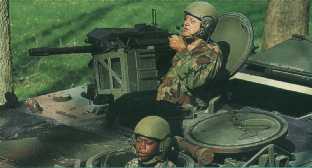
The dismounting U.S. Army Infantry Soldier and his weapons...

M9 Wire Cutter Bayonet

AN/PVS-7B Night Vision Goggles
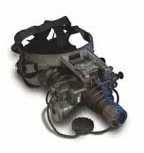
AN/PVS-4 Night Vision Device "Starlight scope"
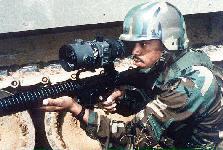
Hand grenades

M9 9mm pistol

M16A1 5.56mm Assault Rifle

+M203 40mm Grenade launcher
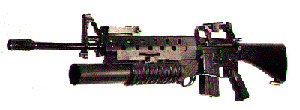
M249 5.56mm Light Machine Gun

M60 7.62mm Medium Machine Gun

M60 MMG Plastic Ammo Boxes
M24 7.62mm Sniper Weapon System (SWS)

M136 AT4 84mm anti-armor/assault rocket

M47 Dragon or Javelin Medium ATGM

The 4th Alabama receives Javelins after the 29th LID of Virginia
M18 Claymore anti-personnel mine

C4 Plastic explosives
Breach Kits
AN/PRC-77 FM radio
AN/PRC-126 FM radio

TA-1 sound-powered field phones
TA-312 battery-powered field phones
E-mail the 4th Alabama Veterans Organization webmaster!


THIS UNOFFICIAL WEB SITE IS THE PROPERTY OF THE VETERANS OF THE 4TH ALABAMA AND USES INFORMATION FOUND IN THE PUBLIC DOMAIN OF THE INTERNET WWW AND/OR CREATED BY THE VETERANS THEMSELVES.